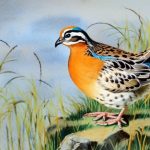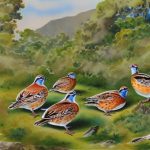Painted quails, also known as button quails, are small, ground-dwelling birds that are popular among aviculture enthusiasts for their colorful plumage and charming personalities. Breeding painted quails can be a rewarding and enjoyable experience for bird lovers, as these birds are relatively easy to care for and breed in captivity. Whether you are a beginner or an experienced breeder, understanding the basics of painted quail breeding is essential for successfully raising healthy quails.
Breeding painted quails requires careful consideration of breeding stock, breeding environment and conditions, incubation and hatching, as well as caring for the chicks. Additionally, being aware of common health issues and proper care practices is crucial for maintaining the well-being of the quails. In this comprehensive guide, we will explore the various aspects of painted quail breeding, providing valuable insights and tips for successful breeding and raising of these delightful birds.
Table of Contents
- 1 Selecting Breeding Stock
- 2 Breeding Environment and Conditions
- 3 Incubation and Hatching
- 4 Caring for Painted Quail Chicks
- 5 Common Health Issues and Care
- 6 Tips for Successful Painted Quail Breeding
- 7 FAQs
- 7.1 What is painted quail breeding?
- 7.2 What are the basic requirements for painted quail breeding?
- 7.3 What is the breeding season for painted quail?
- 7.4 How can I encourage painted quail to breed?
- 7.5 How long does it take for painted quail eggs to hatch?
- 7.6 What should I feed painted quail chicks?
Key Takeaways
- Painted quail breeding is a rewarding hobby that requires careful selection of breeding stock and attention to breeding environment and conditions.
- When selecting breeding stock, look for healthy, active birds with good coloration and markings.
- Provide a breeding environment with proper lighting, temperature, and humidity to encourage successful breeding.
- Incubate quail eggs at the correct temperature and humidity, and provide a safe and clean hatching environment.
- Care for painted quail chicks by providing a balanced diet, warmth, and protection from predators.
Selecting Breeding Stock
Selecting the right breeding stock is crucial for successful painted quail breeding. When choosing breeding stock, it is important to select healthy, mature birds with vibrant plumage and good genetic traits. Look for birds that are active, alert, and free from any signs of illness or deformities. It is also advisable to select birds from different bloodlines to avoid inbreeding and maintain genetic diversity within the breeding population.
When selecting breeding stock, pay attention to the color variations and patterns of the quails, as these traits can be passed down to the offspring. If you have specific color or pattern preferences, choose breeding stock that exhibits these traits. Additionally, consider the temperament of the birds, as gentle and non-aggressive quails are more likely to be successful breeders and parents.
It is recommended to start with a small group of breeding stock, consisting of one male and two to three females. This ratio allows for natural mating behaviors and minimizes competition among the females. As painted quails are social birds, providing a harmonious environment for the breeding stock is essential for successful breeding and egg production.
Breeding Environment and Conditions
Creating a suitable breeding environment and conditions is essential for encouraging natural mating behaviors and successful egg production in painted quails. The breeding enclosure should provide ample space for the quails to move around freely, as well as privacy for nesting and brooding activities. A spacious aviary or cage with plenty of hiding spots, such as plants, branches, and shelters, will help reduce stress and promote natural behaviors in the breeding stock.
The substrate of the breeding enclosure should consist of a mixture of sand and soil, which mimics the natural ground cover of the quail’s habitat. This substrate allows the quails to engage in dust bathing, which is essential for maintaining their plumage and overall health. Additionally, providing a variety of perches and platforms within the enclosure will encourage exercise and natural behaviors in the quails.
Maintaining optimal environmental conditions, such as temperature and lighting, is crucial for successful painted quail breeding. The breeding enclosure should be kept at a consistent temperature of around 75-80°F (24-27°C) to ensure the comfort and well-being of the quails. Providing a natural light cycle with 12-14 hours of daylight will help regulate the breeding behavior and reproductive cycles of the quails.
It is important to monitor the breeding environment for cleanliness and hygiene, as a clean environment is essential for preventing disease and maintaining the health of the breeding stock. Regularly clean and disinfect the enclosure, feeders, and waterers to minimize the risk of bacterial or parasitic infections. By creating a suitable breeding environment and conditions, you can provide the ideal setting for painted quails to engage in natural mating behaviors and successful breeding activities.
Incubation and Hatching
Once the breeding stock has successfully mated and laid eggs, it is essential to provide proper incubation conditions for hatching the quail chicks. Painted quail eggs typically have an incubation period of 16-18 days, during which they require consistent temperature and humidity levels for successful hatching. Investing in a reliable egg incubator with automatic temperature and humidity controls is recommended for ensuring optimal conditions for hatching.
When transferring the eggs to the incubator, handle them with care to avoid any damage to the delicate shells. Position the eggs in a horizontal orientation within the incubator, ensuring that they are not overcrowded and have sufficient space for air circulation. Maintain a steady temperature of around 99-100°F (37-38°C) within the incubator, as fluctuations in temperature can negatively impact the development of the embryos.
Humidity levels within the incubator should be maintained at around 45-50% during the first 14 days of incubation, increasing to 60-70% during the final days leading up to hatching. Proper humidity levels are essential for preventing the eggs from drying out and ensuring successful hatching of healthy quail chicks. It is important to regularly monitor the temperature and humidity levels within the incubator, making adjustments as needed to maintain optimal conditions for hatching.
As the hatch date approaches, observe the eggs closely for any signs of pipping or movement from within the shells. Pipping refers to the process where the chicks begin to break through the eggshell using their egg tooth, signaling that hatching is imminent. Once the chicks have hatched, carefully transfer them to a brooder setup with appropriate heat lamps and bedding to ensure their warmth and comfort during the critical early stages of development.
Caring for Painted Quail Chicks
Caring for painted quail chicks requires attentive monitoring and proper husbandry practices to ensure their health and well-being during the early stages of development. Upon hatching, it is essential to provide a warm and secure brooder setup for the chicks, maintaining a temperature of around 95-100°F (35-38°C) during the first week of life. Gradually reduce the temperature by 5°F each week until reaching ambient room temperature, allowing the chicks to acclimate gradually.
The brooder setup should include a non-slippery flooring material, such as paper towels or rubber shelf liner, to prevent leg deformities and injuries in the chicks. Provide access to fresh water and starter feed formulated specifically for gamebird or quail chicks, ensuring that they receive essential nutrients for healthy growth and development. Additionally, offering small dishes of chick grit will aid in digestion and support overall digestive health in the chicks.
Regularly monitor the chicks for signs of illness or distress, such as lethargy, abnormal droppings, or respiratory issues. Maintaining a clean brooder environment is crucial for preventing disease and promoting optimal health in the chicks. Clean the brooder bedding regularly and ensure that feeders and waterers are kept clean and free from contamination.
As the chicks grow and develop, gradually introduce them to larger enclosures with access to natural substrate for dust bathing and exercise. Providing enrichment activities, such as perches, hiding spots, and interactive toys, will encourage natural behaviors and mental stimulation in the growing quail chicks. By providing attentive care and proper husbandry practices, you can ensure that painted quail chicks thrive and develop into healthy adult birds.
Common Health Issues and Care

Painted quails are generally hardy birds when provided with proper care and husbandry practices; however, they are susceptible to certain health issues that require attention and proactive management. Common health issues in painted quails include respiratory infections, parasitic infestations, nutritional deficiencies, and injuries from aggressive behavior or environmental hazards. It is important to be vigilant in monitoring the health of your quails and addressing any signs of illness or distress promptly.
Respiratory infections can occur in painted quails due to poor ventilation, high humidity levels, or exposure to drafts or airborne pathogens. Symptoms of respiratory infections may include sneezing, coughing, nasal discharge, or labored breathing. Providing a well-ventilated environment with proper air circulation is essential for preventing respiratory issues in quails. Additionally, maintaining cleanliness within the enclosure and regular disinfection of feeders and waterers can help minimize the risk of respiratory infections.
Parasitic infestations, such as mites or lice, can affect painted quails and cause irritation, feather loss, or anemia if left untreated. Regularly inspecting the quails for signs of external parasites and providing dust baths with diatomaceous earth or poultry dust can help prevent parasitic infestations. If infestations occur, prompt treatment with appropriate parasiticides is necessary to eliminate parasites and alleviate discomfort in the affected birds.
Nutritional deficiencies can arise in painted quails if they are not provided with a balanced diet that meets their specific dietary requirements. Ensure that quails have access to high-quality gamebird feed formulated with essential nutrients such as protein, vitamins, and minerals. Supplementing their diet with fresh greens, mealworms, or commercial poultry supplements can help address any potential nutritional deficiencies.
Injuries from aggressive behavior or environmental hazards can occur in multi-bird enclosures if there is overcrowding or insufficient hiding spots for retreat. Monitor the behavior of your quails closely to identify any signs of aggression or bullying within the flock. Providing ample hiding spots, perches, and visual barriers within the enclosure can help reduce stress and minimize aggressive behaviors among the quails.
Tips for Successful Painted Quail Breeding
Successfully breeding painted quails requires attention to detail and proactive management practices to ensure optimal reproductive success and chick rearing. Here are some additional tips for successful painted quail breeding:
1. Provide a balanced diet: Ensure that your breeding stock receives a high-quality diet that meets their specific nutritional requirements for optimal reproductive health.
2. Monitor egg production: Keep track of egg production from each female quail to identify any changes in laying patterns or potential reproductive issues.
3. Minimize stress: Create a calm and harmonious environment for your breeding stock by minimizing disturbances and providing ample hiding spots for privacy.
4. Observe mating behaviors: Pay attention to natural mating behaviors among your breeding stock to ensure successful fertilization of eggs.
5. Maintain records: Keep detailed records of breeding activities, hatch rates, and chick development to track progress and identify any potential issues.
6. Seek veterinary care: If you encounter any health concerns or reproductive issues with your painted quails, seek guidance from an avian veterinarian with experience in treating small bird species.
By implementing these tips and best practices for painted quail breeding, you can enhance your success in raising healthy quails while enjoying the rewarding experience of aviculture. With proper care and attention to their specific needs, painted quails can thrive in captivity and bring joy to bird enthusiasts with their charming personalities and vibrant plumage.
By providing a suitable habitat with plenty of space, a balanced diet, and regular health checks, you can ensure that your painted quails are happy and healthy. Additionally, creating a stress-free environment and carefully monitoring their breeding and nesting behaviors can contribute to successful reproduction. With dedication and knowledge, you can contribute to the conservation of this beautiful species while also enjoying the pleasures of observing their natural behaviors and interactions.
If you’re interested in painted quail breeding, you may also want to explore the topic of chicken coop designs and maintenance. PoultryWizard.com offers a helpful article on the importance of choosing the right heater for a chicken coop, which is crucial for creating a comfortable environment for your birds. Check out their insightful tips and recommendations here.
FAQs
What is painted quail breeding?
Painted quail breeding refers to the process of breeding painted quail, also known as the button quail, in captivity. This involves creating suitable conditions for the quail to mate, lay eggs, and raise their young.
What are the basic requirements for painted quail breeding?
Basic requirements for painted quail breeding include a suitable enclosure with proper ventilation, temperature control, and nesting areas. Additionally, a balanced diet, clean water, and appropriate substrate for egg laying are essential for successful breeding.
What is the breeding season for painted quail?
Painted quail typically breed during the warmer months, with breeding activity peaking in spring and summer. However, with the right conditions, they can breed throughout the year in captivity.
How can I encourage painted quail to breed?
To encourage painted quail to breed, provide a stress-free environment with plenty of hiding spots and nesting materials. Mimicking natural lighting and temperature changes can also stimulate breeding behavior.
How long does it take for painted quail eggs to hatch?
Painted quail eggs typically hatch after an incubation period of 16 to 18 days. It is important to provide a suitable incubator with the correct temperature and humidity levels for successful hatching.
What should I feed painted quail chicks?
Painted quail chicks should be fed a high-protein diet, such as commercial game bird starter feed or finely ground game bird crumbles. It is important to provide access to clean water and small, shallow dishes of feed for the chicks.
Meet Walter, the feathered-friend fanatic of Florida! Nestled in the sunshine state, Walter struts through life with his feathered companions, clucking his way to happiness. With a coop that’s fancier than a five-star hotel, he’s the Don Juan of the chicken world. When he’s not teaching his hens to do the cha-cha, you’ll find him in a heated debate with his prized rooster, Sir Clucks-a-Lot. Walter’s poultry passion is no yolk; he’s the sunny-side-up guy you never knew you needed in your flock of friends!







